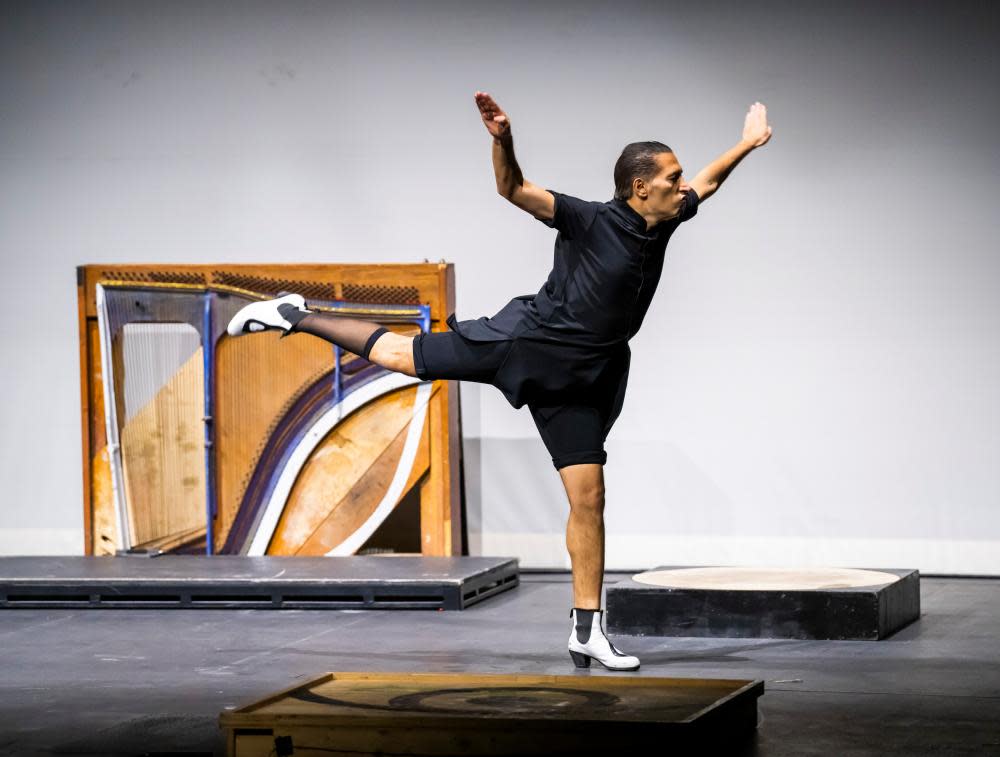Israel Galván: La Consagración de la Primavera review – Stravinsky’s Rite reborn

Israel Galván slinks on to the stage from the open wings and stands in profile, head slightly tilted, arms held away from his sides, wrists flexed, hands flat, like a figure on the side of a Greek vase. Or like Vaslav Nijinsky in one of his most famous roles in L’Après-midi d’un faune.
In white ankle boots and a long, loose black shirt, one leg is covered in shorts, the other in a stocking. Then he begins to move, stamping and sliding his feet in an intricate response to the two exceptional pianists – Daria van den Bercken and Gerard Bouwhuis – who are improvising on two grand pianos on the opposite side of the stage. Microphoned platforms of different surfaces and the innards of an upright piano that Galván casually kicks with a flicked foot are the other elements of the scene.
This is the extraordinary beginning to the most sensational solo interpretation of Stravinsky’s The Rite of Spring. Galván is flamenco royalty, the son of Sevillian stars José Galván and Eugenia de los Reyes. He has been on the flamenco scene since the age of five, and a star in his own right since 1998. But in recent years he has become increasingly experimental, using his immense classical technique to explore new terrain.
This piece seems to be a conversation with both Nijinsky and Stravinsky. After the improvised beginning, the familiar notes of the 1913 music sound out in the version that the composer made for two pianos. Galván responds with steps that seem to burrow into the grooves between the percussive notes, finding rhythms that respond to the score and fill it out, making its soundings seem suddenly new again.
His whole body is full of the music in taps and shudders that run from his head to his toes, little cries, clapping hands as he parades around the space to use each of the different platforms, creating a dense texture of sound. But he also reacts to Nijinsky’s original groundbreaking choreography, where his dancers bent their knees, progressed sideways, held their faces, creating complex shapes that both echo and distort what we know of the original.
By the time the Chosen Maiden, the ritual sacrifice, appears in the score, Galván has pulled on a long skirt so heavy that it impedes his movement, and taken off his shoes. He emerges from the darkness in a great rumble of echoing feet. Supported by a stool, he weaves his arms into wreathing shapes, a single finger extended, as his feet push against the floor, creating a pattern of sound.
He looks like a Paula Rego painting, ghastly but indomitable. Who knows if that is his intent? Whatever the meaning of this interpretation of Stravinsky’s Rite, it’s impossible to tear your eyes away from him; every gesture is freighted with such power. Its impact is slightly lessened by a coda – presumably to lengthen the programme – in which he performs to Scarlatti and to Rzewski’s Winnsboro Cotton Mill Blues.
The results – sometimes danced between the pianos themselves – show Galván’s versatility and his creativity. But it’s the Rite that stays in the mind.

 Yahoo Movies
Yahoo Movies 
